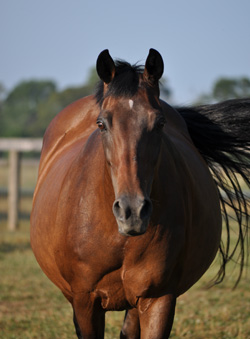 So you just received the results of the 14 day ultra sound and your mare is in foal; congratulations, you have successfully negotiated the first hurdle. Now for the long wait. In the meantime there is a lot to be done to help insure a healthy foal including feeding the mare correctly. But what exactly are a pregnant mares nutrient requirements? Pregnant mares must consume enough nutrients to both maintain their own body weight throughout the pregnancy and also to create new tissues; those of the fetus and those that support the pregnancy such as the placenta. Due to the very small amount of tissue deposition in the first months of pregnancy, providing the mare is in good weight and not working or lactating, she can be fed as a horse at maintenance for the first 4 months. However, due to the development of the tissues supporting the pregnancy, starting in month 5 her nutrient requirements change.
So you just received the results of the 14 day ultra sound and your mare is in foal; congratulations, you have successfully negotiated the first hurdle. Now for the long wait. In the meantime there is a lot to be done to help insure a healthy foal including feeding the mare correctly. But what exactly are a pregnant mares nutrient requirements? Pregnant mares must consume enough nutrients to both maintain their own body weight throughout the pregnancy and also to create new tissues; those of the fetus and those that support the pregnancy such as the placenta. Due to the very small amount of tissue deposition in the first months of pregnancy, providing the mare is in good weight and not working or lactating, she can be fed as a horse at maintenance for the first 4 months. However, due to the development of the tissues supporting the pregnancy, starting in month 5 her nutrient requirements change.
Energy
Fetal growth is greatest during the last 60 days of gestation and therefore traditionally it was not felt necessary to increase energy intake until the 3rd trimester. However, while fetal growth is greatest in the last trimester, more recent research (Reynolds et al., 1986 and Fowden et al., 2000) has shown that during the 2nd trimester there is an increased energy requirement for development of placental tissues. Therefore, the guidelines laid out in the 2007 National Research Council’s (NRC) Nutrient Requirements of Horses recommends that energy in the diet be gradually increased starting at the 5th month of gestation with a greater rate of increase in the last 3 months. Table 1 (below) shows the energy needs of a 500kg mare throughout gestation.
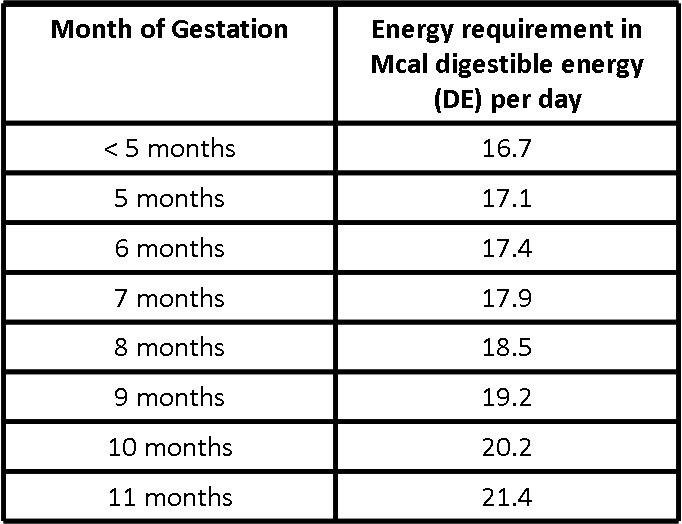 Mares should be seen to gain weight during the last 3 months due to the increasing weight of the foal. Over the entire pregnancy mares can be expected to gain 12-15% of their non-pregnant weight and foal birth weight is estimated to be 9.7% of the mare’s non-pregnant weight. So a foal born to a mare whose non-pregnant weight is 1100lbs will weigh around 107lbs at birth. Mares who do not gain weight during the last trimester will be utilizing their own body energy stores to support fetal growth. This puts the mare at a disadvantage after foaling when she will need those body energy stores for milk production. Mares who do not receive the necessary energy during this time may foal late in an attempt to have their foals be at the correct weight at foaling. If the mare did not enter gestation with a body condition score (BCS) of 5 or above, the energy intakes in table 1 would need to be further increased in order for her to gain weight and have a BCS of 5 by the 9th month.
Mares should be seen to gain weight during the last 3 months due to the increasing weight of the foal. Over the entire pregnancy mares can be expected to gain 12-15% of their non-pregnant weight and foal birth weight is estimated to be 9.7% of the mare’s non-pregnant weight. So a foal born to a mare whose non-pregnant weight is 1100lbs will weigh around 107lbs at birth. Mares who do not gain weight during the last trimester will be utilizing their own body energy stores to support fetal growth. This puts the mare at a disadvantage after foaling when she will need those body energy stores for milk production. Mares who do not receive the necessary energy during this time may foal late in an attempt to have their foals be at the correct weight at foaling. If the mare did not enter gestation with a body condition score (BCS) of 5 or above, the energy intakes in table 1 would need to be further increased in order for her to gain weight and have a BCS of 5 by the 9th month.
The best starting source for the extra energy requirement is from forage. However, as the fetus grows the amount of space within the body cavity for the digestive tract becomes proportionally less and your broodmare may not be physically able to eat the amount of forage that would be necessary to meet her energy requirement. This is especially true if you are feeding lower quality hay with a higher proportion of non-fermentable fiber. Ideally, as for all horses, hay fed to mares and foals should be analyzed for all nutrients including the hays neutral detergent fiber (NDF) and acid detergent fiber (ADF) content which are measures of hay quality.
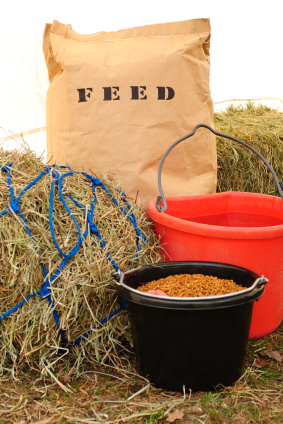 NDF estimates the amount of cell wall material in the hay at the time of cutting. The more mature the hay is at cutting the greater proportion of cell wall material; while NDF does not appear to be the sole determinant of voluntary dry matter intake in horses some studies have shown that as the proportion of NDF increases intakes decrease. Hays with an NDF proportion greater than 65% should be avoided and for broodmares and youngstock a desirable NDF is 55% or less. ADF (cellulose and lignin) increase as the plants in the hay become more mature, the higher the percentage ADF the lower the digestibility of the hay. ADF values over 45% are of little nutritive value and ideally the ADF proportion should be below 32% for broodmares and youngstock. It should be noted that maturity is not a reflection of the cutting (1st, 2nd cuttings etc) it is a reflection of the maturity of the plants when they are cut.
NDF estimates the amount of cell wall material in the hay at the time of cutting. The more mature the hay is at cutting the greater proportion of cell wall material; while NDF does not appear to be the sole determinant of voluntary dry matter intake in horses some studies have shown that as the proportion of NDF increases intakes decrease. Hays with an NDF proportion greater than 65% should be avoided and for broodmares and youngstock a desirable NDF is 55% or less. ADF (cellulose and lignin) increase as the plants in the hay become more mature, the higher the percentage ADF the lower the digestibility of the hay. ADF values over 45% are of little nutritive value and ideally the ADF proportion should be below 32% for broodmares and youngstock. It should be noted that maturity is not a reflection of the cutting (1st, 2nd cuttings etc) it is a reflection of the maturity of the plants when they are cut.
If your mare will not physically eat enough hay to meet her increasing energy needs then you will need to turn to other more energy dense feeds such as grains or commercially compounded feeds. The benefit of starting this before foaling is that the mare will have adjusted to this type of diet before reaching the very demanding metabolic state of lactation. As we saw in table 1, in the last month of gestation the 500kg mare requires 21.4 Mcal per day this increases to 31.7 Mcal once the foal is born and the mare is in the first month of lactation!
Protein
Protein is needed to increase lean body mass so it comes as no surprise that the mare’s protein requirement increases during the last trimester. Interestingly there have been studies (van Niekerk and van Niekerk 1997a) showing that feeding diets deficient in protein may lead to a slower return to ovulation possibly due to lower progesterone concentrations post foaling. This is an important consideration if you are planning on re-breeding your mare. In early pregnancy low protein levels have been linked to lost weight and early fetal loss (van Niekerk and van Niekerk 1997b). The crude protein requirements of the 500kg pregnant mare are shown in Table 2 (below).
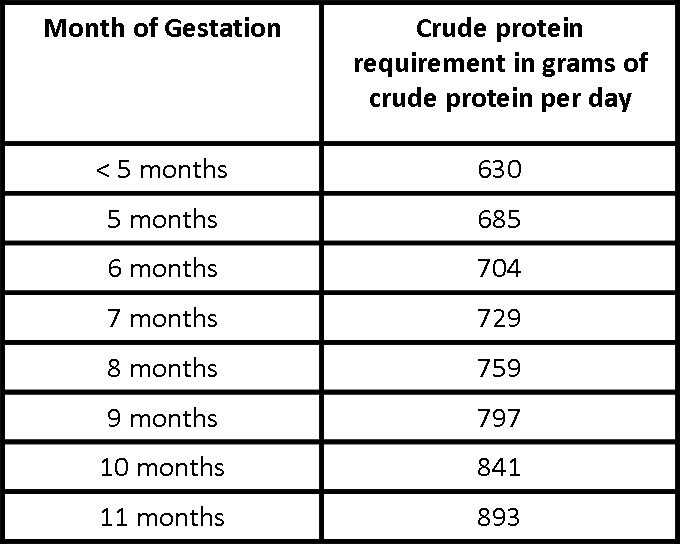 If the 500kg mare (not accounting for extra weight gained during pregnancy) is fed 1.5% of her body weight per day as grass hay (just over 17.5 lbs) with a crude protein level of 10% she will be consuming 800g of protein, enough to meet her requirement through the 9th month. If we assume that she does not eat any greater amount of grass hay in her 10th and 11th months then she would need some protein supplementation from some other source. A lot of people feed their broodmares some proportion of their hay intake as alfalfa because of alfalfa’s higher protein content. If the grass hay intake of our 500kg mare was reduced to just over 14 lbs and just over 3 lbs of a 18% crude protein alfalfa was fed the total crude protein intake would be 920g exceeding the 11th month requirement. As you can see the practice of feeding 30-50% of hay as alfalfa easily insures protein needs are met.
If the 500kg mare (not accounting for extra weight gained during pregnancy) is fed 1.5% of her body weight per day as grass hay (just over 17.5 lbs) with a crude protein level of 10% she will be consuming 800g of protein, enough to meet her requirement through the 9th month. If we assume that she does not eat any greater amount of grass hay in her 10th and 11th months then she would need some protein supplementation from some other source. A lot of people feed their broodmares some proportion of their hay intake as alfalfa because of alfalfa’s higher protein content. If the grass hay intake of our 500kg mare was reduced to just over 14 lbs and just over 3 lbs of a 18% crude protein alfalfa was fed the total crude protein intake would be 920g exceeding the 11th month requirement. As you can see the practice of feeding 30-50% of hay as alfalfa easily insures protein needs are met.
However, hay is generally thought of as a low quality protein source containing fewer of the essential amino acids per unit mass. Therefore to meet the horse’s essential amino acid requirements a greater amount of total crude protein needs to be eaten. While this excess protein may insure these amino acid needs are met much of the non-essential amino acids will need to be excreted and this excess nitrogen increases urea output which can lead to high ammonia levels in stalls and reduced respiratory health. This along with the fact that eating more hay may not be physically possible makes feeding a supplement or concentrate that provides a quality source of protein high in essential amino acids an attractive alternative.
Minerals
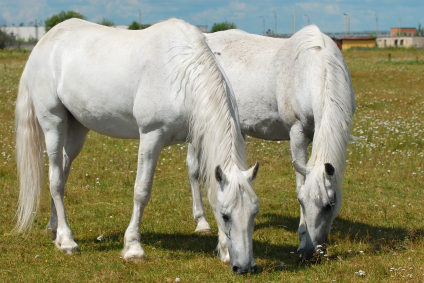 Chloride, copper, iodine, iron, sodium, potassium, magnesium, phosphorous and calcium all have an increased requirement for the last trimester. Most hays are high in iron and potassium and the majority of horses are having their requirements met in excess so adding these nutrients to the diet as a supplement is typically not necessary. Similarly if your mare is receiving adequate salt and any alfalfa in the diet the additional sodium, chloride, iodine, magnesium and calcium requirements are also likely being met.
Chloride, copper, iodine, iron, sodium, potassium, magnesium, phosphorous and calcium all have an increased requirement for the last trimester. Most hays are high in iron and potassium and the majority of horses are having their requirements met in excess so adding these nutrients to the diet as a supplement is typically not necessary. Similarly if your mare is receiving adequate salt and any alfalfa in the diet the additional sodium, chloride, iodine, magnesium and calcium requirements are also likely being met.
Copper and zinc tend to be low in most forages, and it is not unusual for a typical diet to be deficient in one or both of these. Additionally the trace mineral profile of the forage is unlikely to be ideally balanced and this can lead to one mineral competing with another for absorption causing deficiencies even though there may be enough of each mineral present in the diet. Therefore it is a good idea to provide a supplement that will work with the forage to provide additional copper and zinc throughout the pregnancy and improve the ration’s overall mineral balance. This is particularly important for last trimester mares because copper is required for elastic connective tissue and collagen formation which is the main component of bone matrix.
While not the only cause of developmental orthopedic diseases (DOD) in foals, there has been research that suggests that foals born to mares that were given supplemental copper had lower incidents of osteochondrosis even if the foals were given supplemental copper after birth (NRC, 2007). It is thought that supplementing the pregnant mare may promote repair of developing osteochondral lesions in the foal. Therefore it is very important that the mare’s diet provide adequate trace minerals that are correctly balanced to assure absorption and utilization.
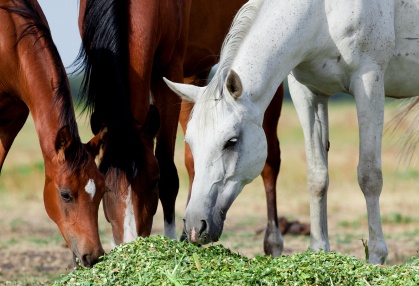
There are many products on the market containing copper and zinc but many provide insufficient amounts to result in correct trace mineral balance. Easy keeping mares may need little more than hay and a ration balancer while others will need the addition of a more energy dense broodmare feed. Keep in mind also that if commercially fortified feeds are being fed at less than the manufacturers recommended intakes this can leave a diet short of essential nutrients such as the trace minerals. A nutritionist can help you determine which commercial feeds and supplements are be best for your mares based on their individual requirements.
Vitamins
There are two classes of vitamins water soluble (B) and fat soluble (A,D, K and E), all but vitamin A and E can be made by the horse. Both vitamin A and E have implications for the brood mare and foal. One of the body stores for vitamin A in the form of beta-carotene (a precursor to vitamin A) is the ovary and namely the corpus luteum where it helps control progesterone secretion and therefore ovulation and embryo implantation. As a result, inadequate beta-carotene in the diet may lead to issues with ovulation and pregnancy maintenance.
While beta-carotene in hay may be adequate to maintain vitamin A in the body, it may not be adequate to maintain ovarian stores of beta-carotene. The plasma beta-carotene content of mares fed pasture is 8 to 13 times higher than mares fed hay (Lewis, 1995). In fact, hay has been found to lose 9.5% of its possible vitamin A per month so that by 6 months after cutting, more than 50% of the possible vitamin A will have been lost. At the same time winter pastures have less vitamin A and beta-carotene than summer pastures and therefore even on pasture mares may have vitamin A insufficiencies (Greiwe-Crandell et al., 1995). In this same study, foals with respiratory infection were found to have reduced vitamin A status. It was unclear whether the infections caused the low vitamin A status or visa versa, but as foals are born without vitamin A stores and rely on transfer of vitamin A in colostrum from their mothers, it is a sensible precaution to insure the mare’s vitamin A status is adequate prior to foaling. This could be especially true for mares that foal early before spring pastures and new hay become available. NRC requirement for vitamin A is 60 IU/kg body weight for mares and 45 IU/kg body weight for foals.
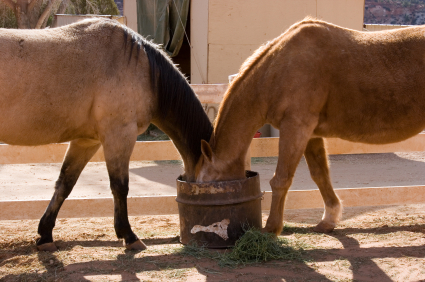 Vitamin E is not heat stable and levels in hay are therefore very low compared to those in fresh pasture. Research has shown improved immune status (higher IgG levels) in foals born to mares supplemented with 160 IU vitamin E per kg dry matter consumed. It was not confirmed that these foals in fact had improved health, but resistance to systemic infections and respiratory diseases is dependent on the amount of colostrol IgG absorbed (Lewis, 1995) and so it is good insurance to assure that mares are consuming adequate vitamin E prior to colostrum production which occurs in the last month of gestation. This is especially true for mares receiving most of their diet as hay.
Vitamin E is not heat stable and levels in hay are therefore very low compared to those in fresh pasture. Research has shown improved immune status (higher IgG levels) in foals born to mares supplemented with 160 IU vitamin E per kg dry matter consumed. It was not confirmed that these foals in fact had improved health, but resistance to systemic infections and respiratory diseases is dependent on the amount of colostrol IgG absorbed (Lewis, 1995) and so it is good insurance to assure that mares are consuming adequate vitamin E prior to colostrum production which occurs in the last month of gestation. This is especially true for mares receiving most of their diet as hay.
Summary
Mares should be fed as much of their nutrient requirement in the form of good quality hay and pasture as possible. Supplemental grain should be fed as necessary to maintain condition. Quality protein should be provided to insure adequate essential amino acid intakes and supplemental copper, zinc and vitamin E should be supplemented along with vitamin A if there are concerns about the vitamin A status of the diet. Several manufacturers make products that provide fortified minerals and quality protein at approximately 12 or 30% of the product, the lower protein level being ideal for mares receiving some alfalfa and the 30% products being ideal for mares on grass hay.
These products are made to be fed at approximately 1-2 lbs per day. Should more calories be required for weight gain or maintenance of condition than provided by these feeds, a feed specifically manufactured for brood mares and growing youngstock may be fed in higher amounts. You should read the manufacturers feeding instructions to find out the amount to feed and whether the product should be combined with a more fortified feed if fed below their recommended feeding levels in order to insure adequate vitamin and mineral intakes.
If you are unclear as to the best approach for feeding your brood mare during the last months of her pregnancy and as she transitions to lactation you may want to consider working with a specialist independent equine nutritionist who will be able to evaluate your horse’s specific needs and help you put together an optimal diet. Providing for your late gestation mare’s dietary needs will insure that her foal is in vibrant health, skeletally strong, and has a robust immune system. Additionally your mare will be in the best health producing enough milk to feed her foal while being reproductively able to breed again should you so desire.
See Also:
The Case Against High Starch Feeds for Pregnant Broodmares
________________________________________________________________________________________
Dr. Clair Thunes owner of Summit Equine Nutrition LLC is available to create tailor made nutrition programs for breeding farms and performance stallions. Her Strong StartTM program ensures correct nutrition from conception to yearling. Contact her at clair@summit-equine.com or 916-248-8987 to learn more about how her programs can benefit your farm.
________________________________________________________________________________________
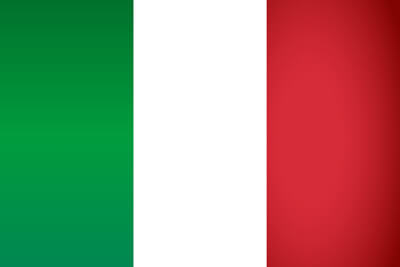
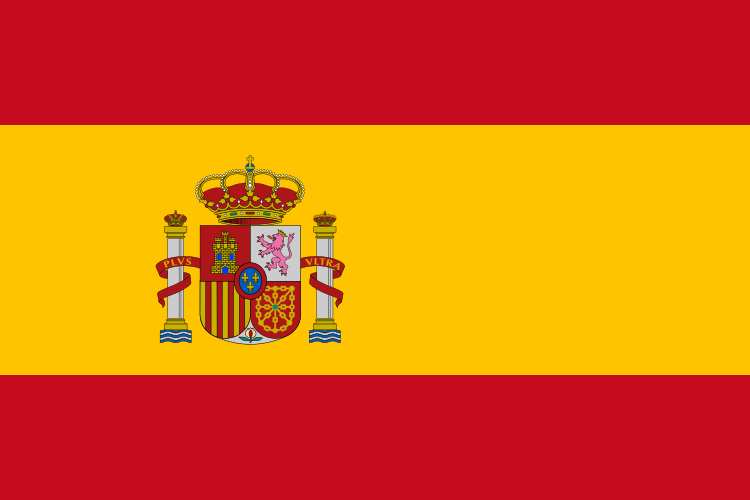
Log in to join the conversation.